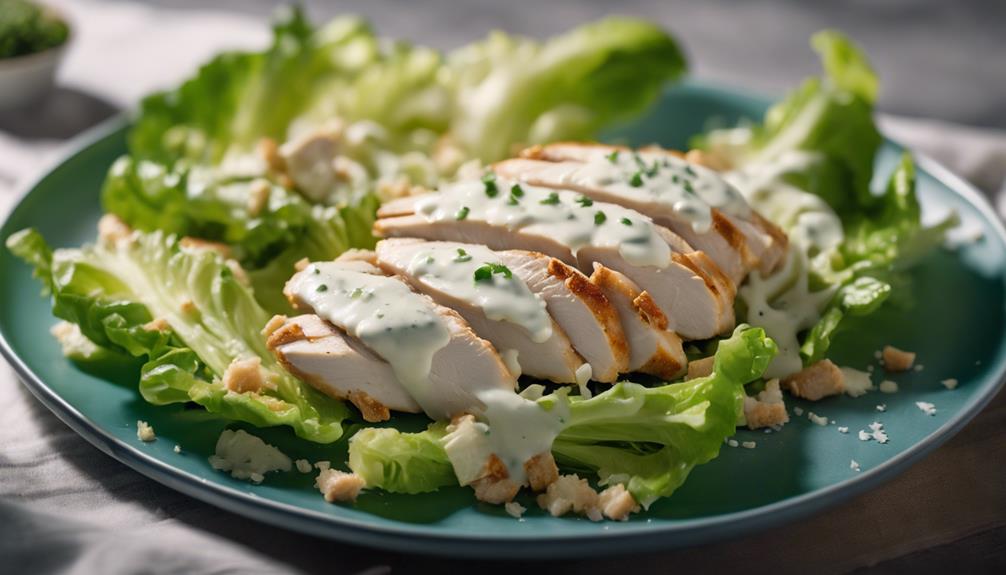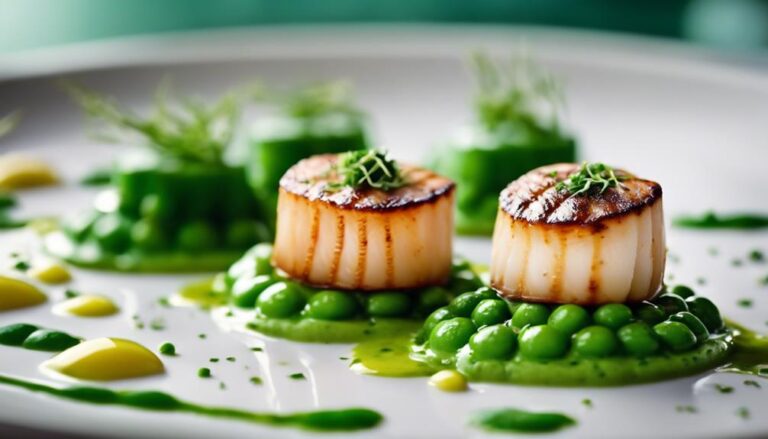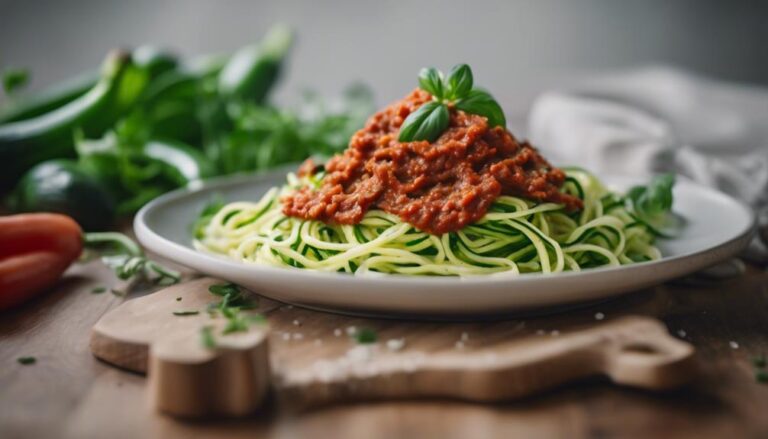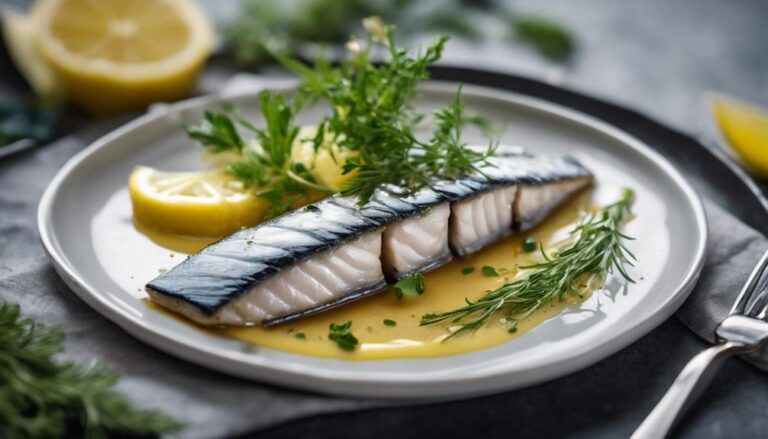Sous Vide Chicken Caesar Salad
For a delicious Sous Vide Chicken Caesar Salad, start by cooking chicken breasts sous vide for tender, juicy results. Season the chicken, seal it in a bag, and cook it in a water bath at a precise temperature. Once cooked, sear the chicken for a golden crust. Mix with fresh romaine lettuce, Caesar dressing, croutons, and Parmesan. This fusion of sous vide chicken with classic Caesar salad is a modern take on a traditional favorite, combining flavors beautifully. Want to elevate your salad game? Try this mouthwatering dish for a delightful twist on a classic Caesar salad.
What You Will Learn Here
- Sous vide cooking ensures perfectly tender and juicy chicken for salads.
- Caesar salad dressing can be prepared traditionally or with a modern twist.
- Precision in cooking temperature enhances flavors and textures.
- Sous vide method guarantees food safety and optimal taste.
- Creative presentation options elevate the classic Caesar salad experience.
Origin of Sous Vide Technology

Sous Vide technology is a method of cooking food at precise temperatures in vacuum-sealed bags. It was invented in the 1970s by French and American engineers. This culinary technique guarantees consistent results and enhanced flavors in dishes, revolutionizing the way chefs approach cooking.
Today, Sous Vide has become a staple in modern kitchens. It allows for unparalleled control and precision in the culinary world.
Sous Vide Invention
The origins of sous vide technology can be traced back to the late 1960s when French and American engineers collaborated to develop a cooking method that involved vacuum-sealing food and cooking it at precise low temperatures. This innovative technique revolutionized the culinary world by offering a range of benefits and advancements in cooking technology.
Sous vide cooking methods involve placing ingredients in a vacuum-sealed bag and immersing it in a water bath at a consistent low temperature for an extended period. This precise cooking process helps retain the flavors, juices, and nutrients of the food, resulting in tender and evenly cooked dishes. The sous vide technology has found applications in professional kitchens, home cooking, and even commercial food production, allowing chefs and food enthusiasts to achieve unparalleled consistency and quality in their dishes.
The development of sous vide technology marked a significant milestone in the culinary industry, paving the way for a new era of cooking that emphasizes precision, flavor preservation, and enhanced culinary experiences.
Culinary Precision Method
Developing the culinary precision method was a groundbreaking achievement that transformed cooking techniques and elevated the quality of dishes prepared using sous vide technology. This precision cooking method, a true culinary innovation, originated in the 1970s when French chefs Georges Pralus and Bruno Goussault pioneered the sous vide technique. By vacuum-sealing ingredients in plastic bags and cooking them at precise temperatures in a water bath, chefs could achieve consistent results with unparalleled accuracy. This marked a significant departure from traditional cooking methods, allowing for a level of control over the cooking process that was previously unattainable.
The introduction of the culinary precision method revolutionized the way chefs approached cooking, emphasizing the importance of temperature control and even heat distribution. This innovative approach not only enhanced the flavors and textures of dishes but also ensured food safety by removing the guesswork associated with conventional cooking methods. As chefs continue to explore the possibilities of precision cooking, sous vide technology remains a cornerstone of modern culinary techniques, showcasing the intersection of science and gastronomy.
Modern Cooking Technique
With the advent of modern culinary techniques, the origin of sous vide technology can be traced back to the innovative approach of French chefs in the 1970s. Sous vide, which means 'under vacuum' in French, involves cooking ingredients in vacuum-sealed bags at precise temperatures in a water bath. This method offers several benefits over traditional cooking, such as retaining the food's natural juices, flavors, and nutrients.
Sous vide equipment, once primarily found in high-end restaurants, has become more accessible for home kitchens in recent years. Specialized sous vide machines, immersion circulators, and vacuum sealers are now available for purchase, allowing home cooks to experiment with this precise cooking technique.
Key Salad Components
Enhance your salad by focusing on essential components. To create a delectable Caesar salad, pay attention to these key elements:
- Dressing Variations: Experiment with different dressing options such as traditional Caesar dressing, lemon vinaigrette, or yogurt-based dressings for a healthier twist.
- Crouton Options: Elevate your salad with homemade garlic croutons, whole grain croutons, or even crunchy chickpeas for added protein and fiber.
- Protein Alternatives: Besides sous vide chicken, consider protein alternatives like grilled shrimp, tofu, or seared salmon to cater to different dietary preferences.
- Serving Suggestions: Present your salad elegantly by arranging the ingredients in a bowl or on a plate, ensuring a balanced distribution of protein, greens, and toppings for a satisfying meal.
Tasty Sous Vide Creations
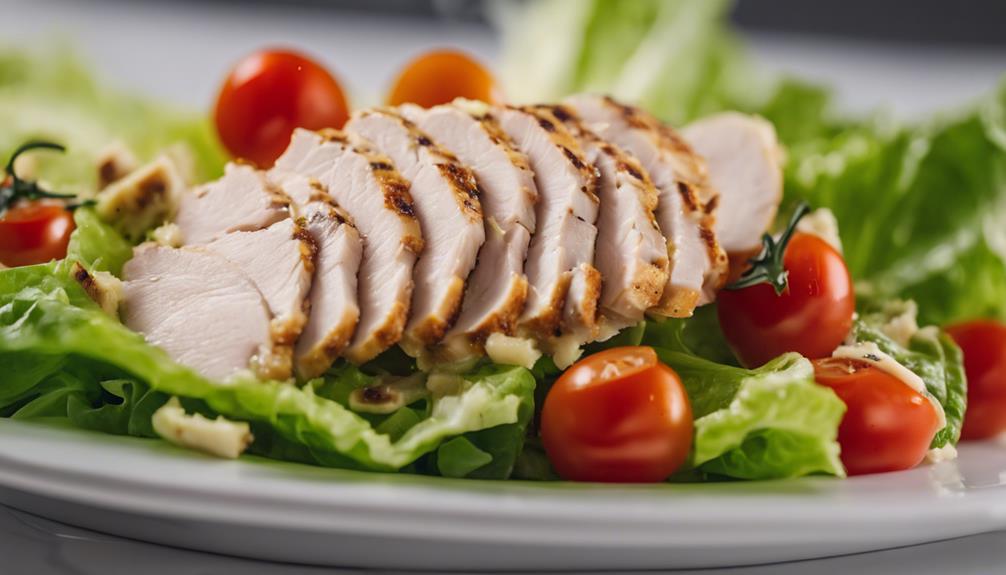
Explore a world of delicious possibilities with sous vide cooking.
From a savory chicken sous vide recipe to succulent sous vide lobster tail and decadent sous vide creme brulee, the options are endless.
Elevate your culinary skills and impress your taste buds with these mouthwatering sous vide creations!
Savory Chicken Sous Vide Recipe
Achieve juicy and flavorful chicken with this simple yet delicious sous vide recipe. Follow these steps for a mouthwatering dish:
- Preparation: Season chicken breasts with a blend of herbs, garlic, and olive oil in a resealable bag.
- Cooking: Submerge the bag in a water bath at precisely controlled temperature for a few hours until the chicken reaches the desired doneness.
- Searing: Finish the chicken on a hot pan or grill for a crispy outer layer.
- Assembly: Slice the chicken and serve over a bed of fresh greens, cherry tomatoes, and a drizzle of creamy homemade Caesar dressing.
Sous Vide Lobster Tail
Moving from the savory chicken sous vide recipe, explore the world of exquisite flavors with a succulent sous vide lobster tail preparation. When it comes to lobster recipes, sous vide cooking techniques can elevate this luxurious seafood to a whole new level. Here are four key points to take into account:
- Precise Temperature Control: Sous vide guarantees that the lobster tail is cooked evenly throughout, preserving its delicate texture and natural flavors.
- Infusion of Flavors: By vacuum-sealing the lobster tail with herbs, butter, or spices before cooking, the flavors are incorporated into the meat, enhancing its taste profile.
- Butter Basting: After sous vide cooking, a quick sear in a hot pan with butter not only adds a rich flavor but also gives the lobster tail a beautiful caramelized finish.
- Serving Elegance: Plating the sous vide lobster tail with a drizzle of clarified butter, a sprinkle of fresh herbs, and a wedge of lemon adds a touch of elegance to this delectable dish.
Discover the art of sous vide lobster tail for a truly unforgettable dining experience.
Sous Vide Creme Brulee
For a delectable dessert with a perfectly creamy texture and a crisp caramelized topping, try making Creme Brulee using the sous vide method. Here's how to elevate your dessert game:
- Preparation: Begin by whisking together egg yolks, sugar, and vanilla extract. Slowly add heated cream while whisking continuously to create a smooth custard base.
- Sous Vide Cooking: Pour the custard mixture into individual ramekins and seal them in airtight bags. Cook in a water bath at a precise temperature for a luxuriously silky texture.
- Chilling: After cooking, refrigerate the Creme Brulee to set the custard. This step guarantees a perfect consistency before adding the final touch.
- Caramelization: Sprinkle a layer of sugar on top of the chilled custard and caramelize it using a culinary torch for that signature crackling sugar crust.
Sous vide Creme Brulee opens up a world of dessert variations, allowing you to experiment with flavors and textures. So why not indulge in this classic treat with a modern twist?
Sous Vide Temperature Recommendations
When preparing sous vide dishes, it's important to be mindful of the ideal cooking temperatures, ensuring your food is both safe and delicious. Safety precautions like proper sealing of ingredients and monitoring water temperature are key considerations in sous vide cooking.
Maintaining a consistent water temperature throughout the cooking process is essential for achieving the perfect results in your sous vide creations.
Ideal Cooking Temperatures
To guarantee your chicken is perfectly cooked using the sous vide method, it's crucial to know the ideal temperature recommendations. Sous vide cooking relies heavily on precise temperature control to achieve excellent results. When preparing chicken, it's recommended to cook it at 140°F (60°C) for a tender and juicy outcome. This temperature ensures that the chicken is safe to eat while retaining its moisture and tenderness.
Sous vide cooking techniques involve sealing the chicken in an airtight bag and immersing it in a water bath at the desired temperature. This method allows for even cooking throughout the chicken breast, eliminating any risk of undercooked or overcooked areas. By maintaining a consistent temperature, food safety concerns commonly associated with traditional cooking methods are greatly reduced.
Understanding the ideal cooking temperatures for sous vide chicken not only guarantees a delicious meal but also prioritizes food safety. By following these temperature recommendations, you can enjoy a perfectly cooked chicken Caesar salad without any worries.
Safety Precautions for Sous Vide
Using precise temperature control in sous vide cooking is vital to guarantee safety and ideal results. To secure food safety when using sous vide equipment, it's essential to follow proper handling and sous vide preparation guidelines.
The recommended temperature for cooking poultry such as chicken in sous vide is 140°F (60°C) to 165°F (74°C), as this range effectively eliminates harmful bacteria while maintaining a juicy texture. Make sure to preheat the water bath to the desired temperature before placing the vacuum-sealed ingredients in for cooking.
It's important to monitor the water temperature consistently throughout the cooking process to prevent any fluctuations that could affect the outcome. By adhering to the recommended temperatures and practicing safe sous vide techniques, you can enjoy delicious and safely cooked meals every time.
Remember that maintaining the correct temperature is key to achieving the best results in sous vide cooking.
Maintaining Water Temperature
Maintaining the water temperature accurately in sous vide cooking is essential for achieving excellent results and guaranteeing food safety. Temperature accuracy is vital to keep your food at the precise doneness level without the risk of undercooking or overcooking.
To achieve this, make sure your sous vide machine has proper water circulation. This ensures that the water temperature remains consistent throughout the cooking process, allowing your food to cook evenly.
Regular equipment maintenance is also important. Check your sous vide machine for any signs of wear and tear that could affect its performance. Additionally, always inspect your sous vide bags for any leaks or damage before use to prevent water from seeping in and affecting the cooking temperature.
Final Thoughts
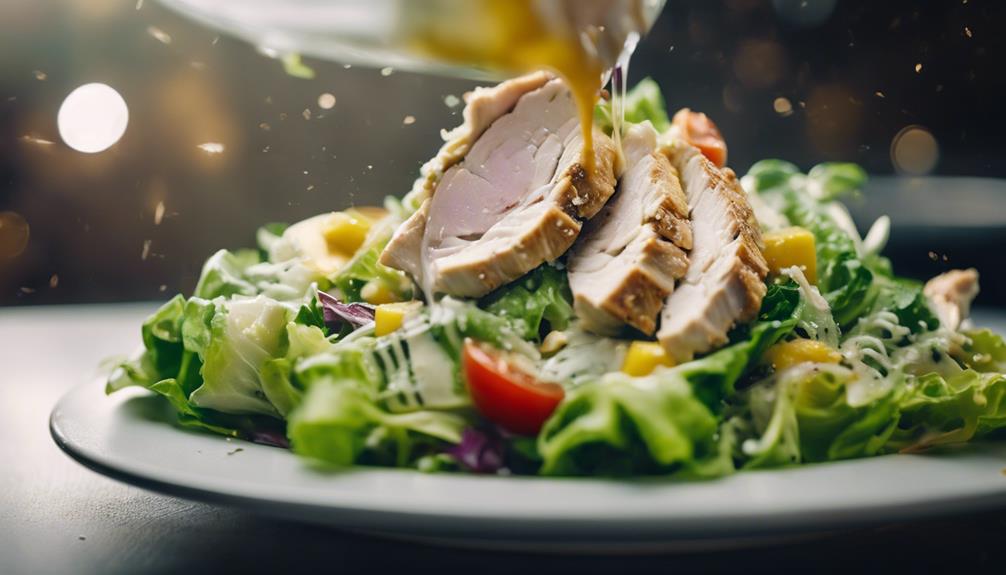
Consider wrapping up your Sous Vide Chicken Caesar Salad experience with some key takeaways. When it comes to dressing variations and serving options, don't be afraid to get creative. Experiment with different types of Caesar dressings or try serving the salad in a crispy Parmesan cheese bowl for added flair. Remember, the dressing can make or break the dish, so choose one that complements the flavors of your sous vide chicken perfectly.
In terms of nutritional benefits, this salad packs a protein punch from the sous vide chicken while offering a good dose of vitamins and minerals from the fresh greens. To make meal prep easier, consider prepping your ingredients in advance and storing them separately until ready to assemble. This way, you can enjoy a quick and delicious meal without the hassle of last-minute preparations.
Whether you're looking for a healthy lunch option or a light dinner, this Sous Vide Chicken Caesar Salad is sure to satisfy your cravings while keeping your nutrition in check. Enjoy the convenience of sous vide cooking paired with the classic flavors of a Caesar salad for a truly delightful dining experience.
Frequently Asked Questions
Can I Use a Regular Pot for Sous Vide Cooking?
Yes, you can use a regular pot for sous vide cooking. Just make sure to use cooking bags to keep your food sealed and submerged. This method helps guarantee proper cooking and ensures even cooking throughout.
How Long Can I Store Caesar Salad Dressing?
You can store Caesar salad dressing in the fridge for about 1-2 weeks. Remember to check for any signs of spoilage. For the best quality and food safety, always follow the recommended shelf life guidelines.
What Other Proteins Can Be Cooked Sous Vide?
When considering proteins for sous vide cooking, options like sous vide steak and sous vide salmon come to mind. These methods yield tender, flavorful results by sealing ingredients in airtight bags and immersing them in precisely controlled water temperatures.
Can I Reuse Sous Vide Cooking Bags?
Yes, you can reuse sous vide cooking bags, but it's important to prioritize hygiene. Consider the environmental impact as well. Proper storage and thorough cleaning are important to maintain food safety and minimize contamination risks.
How Can I Prevent Overcooking Chicken With Sous Vide?
To prevent overcooking when using the sous vide technique, make sure to set the precise temperature and time for your chicken. Seal it properly in a bag, ensuring no air pockets. Monitor the cooking process closely for perfect results.
Conclusion
To sum up, sous vide chicken caesar salad is a delicious and convenient meal option that combines the tenderness of sous vide chicken with the fresh flavors of a classic caesar salad.
By employing precise temperature control, you can guarantee that the chicken is perfectly cooked every time. Experiment with different toppings and dressings to customize your salad to your liking.
Give sous vide cooking a try for a unique and flavorful dining experience.
